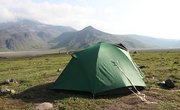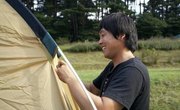Ozark Trail makes dozens of tents and shelters for campers, beachgoers and backyard loungers alike. Though some combine the tent and screened enclosure ideas to give you a few ways to use your shelter, the company's Screenhouse model is what it says it is -- and a small carport too. If you're trying to put together the 10-by-13-foot or 12-by-14-foot model, the same instructions will apply. In about 15 minutes, you should be basking in the shade.
Spread out your poles and connecting joints on the ground. Lay your screen cloth out flat nearby.
Make three poles made of three pole sections marked "2B" and a final pole section marked "2".
Place the two joint sections marked "T" on either side of the pole that will be your center, most-elevated pole.
Place end joints firmly onto the two other longest poles that will be the sides of the your Screenhouse. Put one "L" joint and one "R" joint on each pole, then orient them to accept poles from the center pole's direction.
Make four connecting poles, each with a section marked "1" and "1B". Connect the ends of the center and side poles of your shelter.
Make two poles, each with a section marked "5" and "5B". Place the end pegs of each of these small poles in the corresponding holes at the middle of the center and side poles. This will be a support at mid-shelter.
Make four side posts, with two sections marked "1B" at the top and one section marked "4" for the base of the posts.The end of each "4" section should have the end with the hole pointing downward for use with the screen.
Walk around your Shelterhouse and press each section's joint firmly and completely into place.
Throw the screen cloth onto the roof of the skeleton and connect each corner to the bottom of each pole with the connected hook.
Connect the inside of the Screenhouse to the poles with the connected straps.
Tips
- Stake down the tent where you want it through the provided o-rings, and use the provided guy lines to give your shelter a more permanent wind-resistance.
References
Tips
- Stake down the tent where you want it through the provided o-rings, and use the provided guy lines to give your shelter a more permanent wind-resistance.
Writer Bio
Dan Harkins has been a full-time journalist since 1997. Prior to working in the alternative press, he served as a staff writer and editor for daily publications such as the "St. Petersburg Times" and "Elyria Chronicle-Telegram." Harkins holds a Bachelor of Arts in journalism from the University of South Florida.



